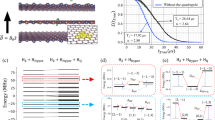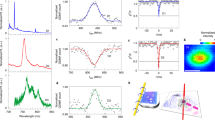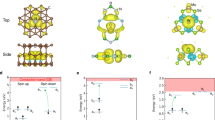Koehl, W. F., Buckley, B. B., Heremans, F. J., Calusine, G. & Awschalom, D. D. Room temperature coherent control of defect spin qubits in silicon carbide. Nature 479, 84–87 (2011).
Article
CAS
Google Scholar
Weber, J. et al. Quantum computing with defects. Proc. Natl Acad. Sci. USA 107, 8513–8518 (2010).
Article
CAS
Google Scholar
Liu, X. & Hersam, M. C. 2D materials for quantum information science. Nat. Rev. Mater. 4, 669–684 (2019).
Article
Google Scholar
Aharonovich, I. & Toth, M. Quantum emitters in two dimensions. Science 358, 170–171 (2017).
Article
CAS
Google Scholar
Mendelson, N., Doherty, M., Toth, M., Aharonovich, I. & Tran, T. T. Strain-induced modification of the optical characteristics of quantum emitters in hexagonal boron nitride. Adv. Mater. 32, 1908316 (2020).
Article
CAS
Google Scholar
Feldman, M. A. et al. Phonon-induced multicolor correlations in hBN single-photon emitters. Phys. Rev. B 99, 020101 (2019).
Article
CAS
Google Scholar
Yim, D., Yu, M., Noh, G., Lee, J. & Seo, H. Polarization and localization of single-photon emitters in hexagonal boron nitride wrinkles. ACS Appl. Mater. Int. 12, 36362–36369 (2020).
Article
CAS
Google Scholar
Mackoit-Sinkevičienė, M., Maciaszek, M., Van de Walle, C. G. & Alkauskas, A. Carbon dimer defect as a source of the 4.1 eV luminescence in hexagonal boron nitride. Appl. Phys. Lett. 115, 212101 (2019).
Article
CAS
Google Scholar
Kianinia, M., White, S., Fröch, J. E., Bradac, C. & Aharonovich, I. Generation of spin defects in hexagonal boron nitride. ACS Photonics 7, 2147–2152 (2020).
Article
CAS
Google Scholar
Turiansky, M., Alkauskas, A. & Walle, C. Spinning up quantum defects in 2D materials. Nat. Mater. 19, 487–489 (2020).
Article
CAS
Google Scholar
Li, X. et al. Nonmagnetic quantum emitters in boron nitride with ultranarrow and sideband-free emission spectra. ACS Nano 11, 6652–6660 (2017).
Article
CAS
Google Scholar
Ivády, V., Abrikosov, I. A. & Gali, A. First principles calculation of spin-related quantities for point defect qubit research. npj Comput. Mater. 4, 1–13 (2018).
Article
Google Scholar
Komsa, H.-P., Berseneva, N., Krasheninnikov, A. V. & Nieminen, R. M. Charged point defects in the flatland: accurate formation energy calculations in two-dimensional materials. Phys. Rev. X 4, 031044 (2014).
CAS
Google Scholar
Wang, D. et al. Determination of formation and ionization energies of charged defects in two-dimensional materials. Phys. Rev. Lett. 114, 196801 (2015).
Article
CAS
Google Scholar
Wu, F., Galatas, A., Sundararaman, R., Rocca, D. & **, Y. First-principles engineering of charged defects for two-dimensional quantum technologies. Phys. Rev. Mater. 1, 071001 (2017).
Article
Google Scholar
Govoni, M. & Galli, G. Large scale GW calculations. J. Chem. Theory Comput. 11, 2680–2696 (2015).
Article
CAS
Google Scholar
Smart, T. J., Wu, F., Govoni, M. & **, Y. Fundamental principles for calculating charged defect ionization energies in ultrathin two-dimensional materials. Phys. Rev. Mater. 2, 124002 (2018).
Article
CAS
Google Scholar
Nguyen, N. L., Colonna, N., Ferretti, A. & Marzari, N. Koopmans-compliant spectral functionals for extended systems. Phys. Rev. X 8, 021051 (2018).
Google Scholar
Weng, M., Li, S., Zheng, J., Pan, F. & Wang, L.-W. Wannier Koopmans method calculations of 2D material band gaps. J. Chem. Phys. Lett. 9, 281–285 (2018).
Article
CAS
Google Scholar
Miceli, G., Chen, W., Reshetnyak, I. & Pasquarello, A. Nonempirical hybrid functionals for band gaps and polaronic distortions in solids. Phys. Rev. B 97, 121112 (2018).
Article
CAS
Google Scholar
Refaely-Abramson, S., Qiu, D. Y., Louie, S. G. & Neaton, J. B. Defect-induced modification of low-lying excitons and valley selectivity in monolayer transition metal dichalcogenides. Phys. Rev. Lett. 121, 167402 (2018).
Article
CAS
Google Scholar
Gao, S., Chen, H.-Y., Bernardi, M. Radiative properties and excitons of candidate defect emitters in hexagonal boron nitride. Preprint at ar**v:2007.10547 (2020).
Xu, J., Habib, A., Kumar, S., Wu, F., Sundararaman, R. & **, Y. Spin-phonon relaxation from a universal ab initio density-matrix approach. Nat. Commun. 11, 1–10 (2020).
Google Scholar
Seo, H., Falk, A. L., Klimov, P. V., Miao, K. C., Galli, G. & Awschalom, D. D. Quantum decoherence dynamics of divacancy spins in silicon carbide. Nat. Commun. 7, 1–9 (2016).
Article
CAS
Google Scholar
Ye, M., Seo, H. & Galli, G. Spin coherence in two-dimensional materials. npj Comput. Mater. 5, 1–6 (2019).
Article
CAS
Google Scholar
Wu, F., Smart, T. J., Xu, J. & **, Y. Carrier recombination mechanism at defects in wide band gap two-dimensional materials from first principles. Phys. Rev. B 100, 081407 (2019).
Article
CAS
Google Scholar
Thiering, G. & Gali, A. Ab initio calculation of spin–orbit coupling for an NV center in diamond exhibiting dynamic Jahn–Teller effect. Phys. Rev. B 96, 081115 (2017).
Article
Google Scholar
Gottscholl, A. et al. Initialization and read-out of intrinsic spin defects in a van der Waals crystal at room temperature. Nat. Mater. 19, 540–545 (2020).
Article
CAS
Google Scholar
Seo, H., Ma, H., Govoni, M. & Galli, G. Designing defect-based qubit candidates in wide-gap binary semiconductors for solid-state quantum technologies. Phys. Rev. Mater. 1, 075002 (2017).
Article
Google Scholar
Turiansky, M. E., Alkauskas, A., Bassett, L. C. & Walle, C. G. Dangling bonds in hexagonal boron nitride as single-photon emitters. Phys. Rev. Lett. 123, 127401 (2019).
Article
CAS
Google Scholar
Rayson, M. & Briddon, P. First principles method for the calculation of zero-field splitting tensors in periodic systems. Phys. Rev. B 77, 035119 (2008).
Article
CAS
Google Scholar
Zolnhofer, E. M. et al. Electronic structure and magnetic properties of a titanium (II) coordination complex. Inorg. Chem. 59, 6187–6201 (2020).
Article
CAS
Google Scholar
Tran, T. T. et al. Robust multicolor single photon emission from point defects in hexagonal boron nitride. ACS Nano 10, 7331–7338 (2016).
Article
CAS
Google Scholar
Schell, A. W., Takashima, H., Tran, T. T., Aharonovich, I. & Takeuchi, S. Coupling quantum emitters in 2D materials with tapered fibers. ACS Photonics 4, 761–767 (2017).
Article
CAS
Google Scholar
Ahmadpour Monazam, M. R., Ludacka, U., Komsa, H.-P. & Kotakoski, J. Substitutional Si impurities in monolayer hexagonal boron nitride. Appl. Phys. Lett. 115, 071604 (2019).
Article
CAS
Google Scholar
Sajid, A. & Thygesen, K. S. VNCB defect as source of single photon emission from hexagonal boron nitride. 2D Mater. 7, 031007 (2020).
Article
CAS
Google Scholar
Fuchs, F., Bechstedt, F., Shishkin, M. & Kresse, G. Quasiparticle band structure based on a generalized Kohn–Sham scheme. Phys. Rev. B 76, 115109 (2007).
Article
CAS
Google Scholar
Bechstedt, F. Many-Body Approach to Electronic Excitations (Springer-Verlag, 2016).
**, Y., Rocca, D. & Galli, G. Electronic excitations in light absorbers for photoelectrochemical energy conversion: first principles calculations based on many body perturbation theory. Chem. Soc. Rev. 42, 2437–2469 (2013).
Article
CAS
Google Scholar
Rocca, D., **, Y., Gebauer, R. & Galli, G. Solution of the Bethe–Salpeter equation without empty electronic states: application to the absorption spectra of bulk systems. Phys. Rev. B 85, 045116 (2012).
Article
CAS
Google Scholar
**, Y., Rocca, D., Lu, D. & Galli, G. Ab initio calculations of absorption spectra of semiconducting nanowires within many-body perturbation theory. Phys. Rev. B 85, 035316 (2012).
Article
CAS
Google Scholar
**, Y., Rocca, D. & Galli, G. Optical properties of tungsten trioxide from first-principles calculations. Phys. Rev. B 87, 165203 (2013).
Article
CAS
Google Scholar
Hours, J., Senellart, P., Peter, E., Cavanna, A. & Bloch, J. Exciton radiative lifetime controlled by the lateral confinement energy in a single quantum dot. Phys. Rev. B 71, 161306 (2005).
Article
CAS
Google Scholar
Van de Walle, C. G. & Neugebauer, J. First-principles calculations for defects and impurities: applications to III-nitrides. J. Appl. Phys. 95, 3851–3879 (2004).
Article
CAS
Google Scholar
Goldman, M. L. et al. Phonon-induced population dynamics and intersystem crossing in nitrogen-vacancy centers. Phys. Rev. Lett. 114, 145502 (2015).
Article
CAS
Google Scholar
Bassett, L. C. et al. Ultrafast optical control of orbital and spin dynamics in a solid-state defect. Science 345, 1333–1337 (2014).
Article
CAS
Google Scholar
Kim, S. et al. Photonic crystal cavities from hexagonal boron nitride. Nat. Commun. 9, 1–8 (2018).
CAS
Google Scholar
Zhong, T. et al. Optically addressing single rare-earth ions in a nanophotonic cavity. Phys. Rev. Lett. 121, 183603 (2018).
Article
CAS
Google Scholar
Giannozzi, P. et al. QUANTUM ESPRESSO: a modular and open-source software project for quantum simulations of materials. J. Phys.: Condens. Matter 21, 395502 (2009).
Google Scholar
Hamann, D. R. Optimized norm-conserving Vanderbilt pseudopotentials. Phys. Rev. B 88, 085117 (2013).
Article
CAS
Google Scholar
Sundararaman, R. & **, Y. First-principles electrostatic potentials for reliable alignment at interfaces and defects. J. Chem. Phys. 146, 104109 (2017).
Article
CAS
Google Scholar
Wang, D. & Sundararaman, R. Layer dependence of defect charge transition levels in two-dimensional materials. Phys. Rev. B 101, 054103 (2020).
Article
CAS
Google Scholar
Sundararaman, R., Letchworth-Weaver, K., Schwarz, K. A., Gunceler, D., Ozhabes, Y. & Arias, T. JDFTx: software for joint density-functional theory. SoftwareX 6, 278–284 (2017).
Article
Google Scholar
Perdew, J. P., Burke, K. & Ernzerhof, M. Generalized gradient approximation made simple. Phys. Rev. Lett. 77, 3865 (1996).
Article
CAS
Google Scholar
Marini, A., Hogan, C., Grüning, M. & Varsano, D. Yambo: an ab initio tool for excited state calculations. Comput. Phys. Commun. 180, 1392–1403 (2009).
Article
CAS
Google Scholar
Neese, F. The ORCA program system. WIREs Comput. Mol. Sci. 2, 73–78 (2012).
Article
CAS
Google Scholar
Neese, F. Calculation of the zero-field splitting tensor on the basis of hybrid density functional and Hartree–Fock theory. J. Chem. Phys. 127, 164112 (2007).
Article
CAS
Google Scholar
Wu, F., Rocca, D. & **, Y. Dimensionality and anisotropicity dependence of radiative recombination in nanostructured phosphorene. J. Mater. Chem. C 7, 12891–12897 (2019).
Article
CAS
Google Scholar
Gupta, S., Yang, J.-H. & Yakobson, B. I. Two-level quantum systems in two-dimensional materials for single photon emission. Nano Lett. 19, 408–414 (2018).
Article
CAS
Google Scholar
Maze, J. R. et al. Properties of nitrogen-vacancy centers in diamond: the group theoretic approach. N. J. Phys. 13, 025025 (2011).
Article
CAS
Google Scholar
de Souza, B., Farias, G., Neese, F. & Izsák, R. Predicting phosphorescence rates of light organic molecules using time-dependent density functional theory and the path integral approach to dynamics. J. Chem. Theory Comput. 15, 1896–1904 (2019).
Article
CAS
Google Scholar
Towns, J. et al. XSEDE: accelerating scientific discovery. Comput. Sci. Eng. 16, 62–74 (2014).
Article
CAS
Google Scholar








